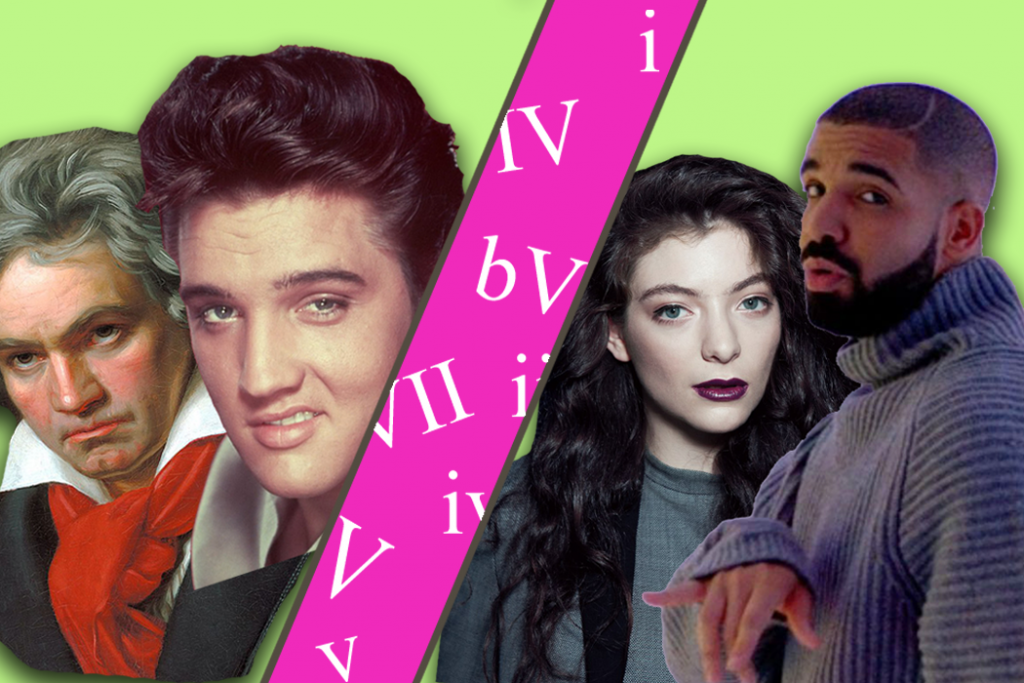+ Welcome to Soundfly! We help curious musicians meet their goals with creative online courses. Whatever you want to learn, whenever you need to learn it. Subscribe now to start learning on the ’Fly.
So there I was, doing research on topics such as “summer 2017 songwriting trends,” when it hit me. You guys, this is getting ridiculous — where did all the functional harmony go? I’m talking about the Music Theory 101, first-day-of-class stuff that we used to see everywhere: dominants, pre-dominants, tonics, authentic cadences — in other words, functions.
Where’d they all go?
Basically, the three essential functions in tonal harmony are the Predominant, most often a two(ii) or four(IV) chord; then the Dominant, almost always a five(V) chord; and then the Tonic, always the one chord(I). In the key of C major, that’d be a Dm or F, then a G, then a C chord, respectively. This chord change, and its variants, is supposed to be the most common and “correct” thing that happens in music.
Elvis and Beethoven would both agree.
Here’s Elvis singing “All Shook Up” — just a whole bunch of one(I) chords, then bam, function: IV – V – I.
Beethoven only needs two of the essential functions to start his “Minuet in G.” Just I – V – I or tonic – dominant – tonic.
Now, back to the issue at hand. Like I said, I was surfing through Google search results for “summertime hits of 2017″ and the like, cross-referencing them for duplicates, and literally, the first six songs I found had none — not even a whiff of any of these textbook-essential functions.
Pop music has officially entered the age of “post-functional.” Or something.
Exhibit A:
Drake’s song “Passionfruit” starts out with some syncopated arpeggios — none of which are even triads, so there’s your first functional harmony torpedo right there — and even if you cheat and label them by their implied triads, i – iv – v chords, it’s still not functioning tonally. That’s because these are modal chords, and according to Music Theory 101, modal chords don’t “function,” per se, they meander — like a lost monk chanting in the woods.
Exhibit B:
Next came Kendrick Lamar’s “Loyalty,” which has a natural minor chord progression of ♭VI – v – i — not classically functional.
His other song on all the lists, “Humble,” uses the same dang motif, but without the chords, so it’s just the chord roots, ♭6, 5, and 1. These “5-1” scale notes are as close as we get to V – I functioning chords. Incidentally, this piano riff can also be heard in a Phrygian tonality as ♭2, 1, 4.
It’s kind of like the famous rabbit-duck illusion where your brain is capable of seeing both a rabbit and a duck in the same image. How is this possible in music? Because the less tonal information you have, the harder it is to be sure where the tonal center is, so your brain starts filling in the gaps with tonal information from your musical preferences and culture. Like, what if you’d never heard a song in natural minor before but those Phrygian bunnies started hopping all around your yard, like, every morning?
What if you’d never seen a duck before? You’d see the rabbit.
+ Learn production, composition, songwriting, theory, arranging, mixing, and more — whenever you want and wherever you are. Subscribe for unlimited access!
Exhibit C:
You’ll never believe this, but the next song, Calvin Harris’s “Slide” (feat. Frank Ocean and Migos), started with that same bVI – v – i progression, later using an even less functional iv – v – bVI progression. No major V chords = no leading tones = no functional cadences = no essential functions.
+ Read more on Flypaper: “How to Add Bittersweet Emotion to Your Chords with 7ths”
Exhibit D:
In “Shape of You,” Ed Sheeran uses a i – iv – bVI – bVII progression… and has red hair. Red hair is also not tonally functional.
Exhibit E:
Lastly, Lorde. Thank you, Lorde — you at least have a major V in your chord progressions for “Green Light,” which are vi – I – IV, IV – vi – V and bVII – IV – I. But, wait, does this major V resolve, functionally, to its tonic one(I) chord?
Nope, sorry, it doesn’t. It resolves about as well as her feelings for this jerk she’s singing about. Oh well, at least we have a “plagal cadence” in there (IV – I), which is kind of functional, I guess.
I mean, I don’t even know what that word should mean anymore or what “functional” is, should, or shouldn’t be.
What Now? Where Do We Go from Here?
By definition, “functional” is a word that means something works, it does stuff. And yes, predominant-dominant-tonic has done a lot of stuff throughout the ages! But it doesn’t do “all the stuff” — not anymore at least. All of this music above, even without “essential functions,” still actually works. Because if it didn’t, it wouldn’t be on multiple “best of the summer” lists.
So why am I pointing all of this out (besides nana-nana-booing my old music school’s curriculum and thinking I’m better than theorists who’ve been dead a hundred years)? I want to scrap, to do away with, the word function altogether.
It’s gotten to the point where it’s just confusing people. We need different words to express what we mean.
How about speaking purely in terms of “resolving” or “leading” in honor of the “leading tone,” which is a note all dominant function chords have. And while none of the music above has a leading tone that leads anywhere, why does music have to lead anywhere?
That’s the danger of continuing to use the word “function.” Isn’t it okay if music meanders, roams, and drifts, eschewing any solid dominant-tonic, or away-home, leading-resolving movement? I mean, Netflix and chill, it’s a crappy job market out there for millennials, I don’t want my music to resolve, to “go home.” Half my friends are living in their parents’ basements. Going home sucks.
There’s still plenty of classically, tonally, or essentially functional music out there, as this guy proves in everyone’s favorite “Pachelbel Rant.”
Speaking of “Pachelbel’s Canon,” brush up on your knowledge of canons and rounds and how to compose them with this useful digression.
It’s not that music doesn’t “function” anymore, it’s just that music functions differently than it used to. There’s a lot more roaming and drifting, and it works just fine, thank you. It’s just that the terms haven’t kept up.
So, let’s ditch the word “functions” for words like “resolves,” “leads,” or “roams.” If we could, maybe our music jargon could be more… functional?
Want to get all of Soundfly’s premium online courses for a low monthly cost?
Subscribe to get unlimited access to all of our course content, an invitation to join our members-only Slack community forum, exclusive perks from partner brands, and massive discounts on personalized mentor sessions for guided learning. Learn what you want, whenever you want, with total freedom.







